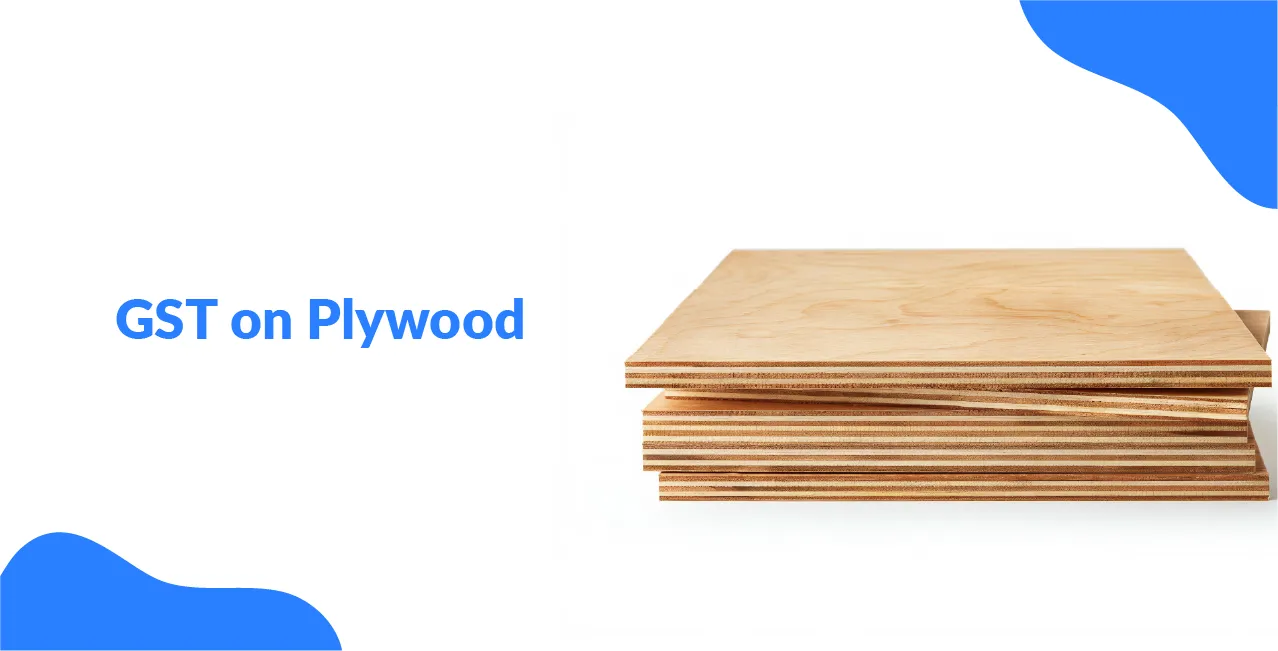
Author
LoansJagat Team
Read Time
5 Min
14 Jul 2025
GST on Plywood – A Carpenter’s Realisation
Neha walked into her regular plywood shop in Pune, looking to buy a few good sheets for a kitchen renovation project. She eyed a neat stack of film-faced plywood priced at ₹1,400 each. “Not bad,” she thought… until the shopkeeper casually added, “Plus 18% GST, madam.”
Wait, what?
Quick mental maths kicked in:
₹1,400 × 18% = ₹252.
So, the real price was ₹1,652 per sheet. Just like that, her project budget stretched a little more.
And that’s exactly how GST on Plywood shows up—quietly sitting on every bill, changing how you plan, quote, and build. Whether you are a carpenter, interior designer, contractor, or just someone doing a bit of home DIY, this tax is something you’ll run into. But here’s the good news—once you understand how it works (and how to make it work for you), it actually starts making sense.
So let’s break it all down, minus the boring bits, with real numbers, cheeky examples, and plenty of "a-ha!" moments. Because when it comes to plywood, tax is not just a percentage—it is a part of the plan.
“Plywood aur GST ke saath budget hua mast!”
GST on Plywood – Category-Wise Table with Price & GST
Now let us look into a table that covers various popular plywood types, sample prices, GST applied, and their final cost.
If you are quoting prices to clients, just multiply your base cost by 1.18 and you have your GST-inclusive figure ready.
HSN Codes for Plywood, Veneers, and Laminates
Each product category has its own HSN (Harmonised System of Nomenclature) code. Picking the wrong one can land you in compliance trouble.
Make sure your invoices and GST returns mention the correct codes. That’s the only way to ensure seamless Input Tax Credit and avoid audit hiccups.
“Yeh plywood ka tax funda, ab sableng clear hai funda!”
Important aspects that others missed: Bamboo & Marine Ply Realities
We are also bringing you exclusive focus on bamboo and marine plywood—both fast-growing yet often misrepresented in online articles.
Bamboo Ply Case Study:
- Quantity: 50 sheets
- Unit Cost: ₹1,600
- Total: ₹80,000
- GST (18%): ₹14,400
- Total Invoice: ₹94,400
- Eligible Input Tax Credit: ₹14,400
Marine Grade Example:
- Quantity: 30 sheets
- Unit Cost: ₹2,200
- Total: ₹66,000
- GST (18%): ₹11,880
- Final Invoice: ₹77,880
Whether eco-conscious bamboo or high-resistance marine boards, GST on Plywood applies equally. But knowing how to manage those taxes makes the real difference.
Why HSN Accuracy is Crucial
Most people skip this bit. But one wrong digit in your HSN code and your GST return could go haywire. Misclassification leads to:
- Denial of Input Tax Credit
- GST officer notices and fines
- E-Way bill mismatches
Every business must get their paperwork tight. Whether you are issuing an invoice or reconciling your GSTR-2B, the HSN code matters as much as the amount.
“Plywood lelo, GST sambhalo, accountant bhi apna kaam fast karo!”
GST and Input Tax Credit (ITC) on Plywood
Now, let us talk about how to make GST work for you.
If you are a GST-registered business and you purchase plywood for business use, you can claim back the GST paid. That means less tax out of your pocket when you file returns.
Example:
- Raw Material (Plywood) Purchased = ₹1,00,000
- GST Paid (18%) = ₹18,000
- Output GST Collected on Sales = ₹28,000
- Net Tax Payable = ₹28,000 – ₹18,000 = ₹10,000
You only pay ₹10,000 instead of ₹28,000 because you’ve claimed your input. That is the power of proper GST management.
Numerical Showdown: Dealer vs Manufacturer
Let’s break it down even further.
Dealer Scenario:
- Buys 100 commercial sheets at ₹1,200 = ₹1,20,000
- GST Paid = ₹21,600
- Sells at ₹1,500 each = ₹1,50,000
- GST Collected = ₹27,000
- Final GST to Pay = ₹27,000 – ₹21,600 = ₹5,400
Manufacturer Scenario:
- Raw plywood = ₹2,00,000
- GST Paid = ₹36,000
- Final furniture sold = ₹3,00,000
- GST Collected = ₹54,000
- Net Tax = ₹54,000 – ₹36,000 = ₹18,000
Managing these numbers lets you control costs, pricing, and profits—just by understanding how GST on Plywood functions in real life.
Where to Check GST Details Online
You can cross-check HSN codes, rates, and ITC eligibility through the official GST Portal. Make sure your invoices match portal data to avoid compliance troubles. You can also file returns, download GSTR-2B, and track your payments from the same portal.
“Tax ka tension nahi, footer me rakho correct mention!”
Conclusion – Let GST on Plywood Work for You
GST on Plywood is straightforward—18% across almost every type. But the way you apply that number, report it, and recover it makes all the difference.
Use the correct HSN codes. Keep all invoices clean and digital. Use portals to match input and output tax. And always remember—every ₹216 you pay in GST per sheet could come back to you as credit.
Carpenters, dealers, architects, and builders: it is time to take tax matters into your own skilled hands.
Next time you spot a price tag on a shiny ply sheet, just do a quick multiply by 1.18. You will be way ahead of anyone still scratching their head at the hardware shop counter.
Frequently asked questions (FAQs)
Q1. Is plywood imported from abroad taxed differently?
No, imported plywood is taxed at 18 %GST plus customs duties. However, IGST paid on import can be claimed as ITC if the buyer is registered.
Q2. Do laminates have the same GST rate as plywood?
Yes, laminates fall under similar HSN codes and attract 18 %GST. But always double-check the sub-code for each product line.
Q3. Can an interior designer claim ITC on plywood purchases?
Absolutely, if the designer is GST registered and uses plywood for business purposes, ITC is fully claimable.
Q4. What happens if I quote the wrong HSN code?
Returns may mismatch, ITC could be blocked, and notices from GST departments may follow. Accuracy is non-negotiable.
Other Important GST Pages | ||||
About the Author

LoansJagat Team
‘Simplify Finance for Everyone.’ This is the common goal of our team, as we try to explain any topic with relatable examples. From personal to business finance, managing EMIs to becoming debt-free, we do extensive research on each and every parameter, so you don’t have to. Scroll up and have a look at what 15+ years of experience in the BFSI sector looks like.

Quick Apply Loan
Subscribe Now


